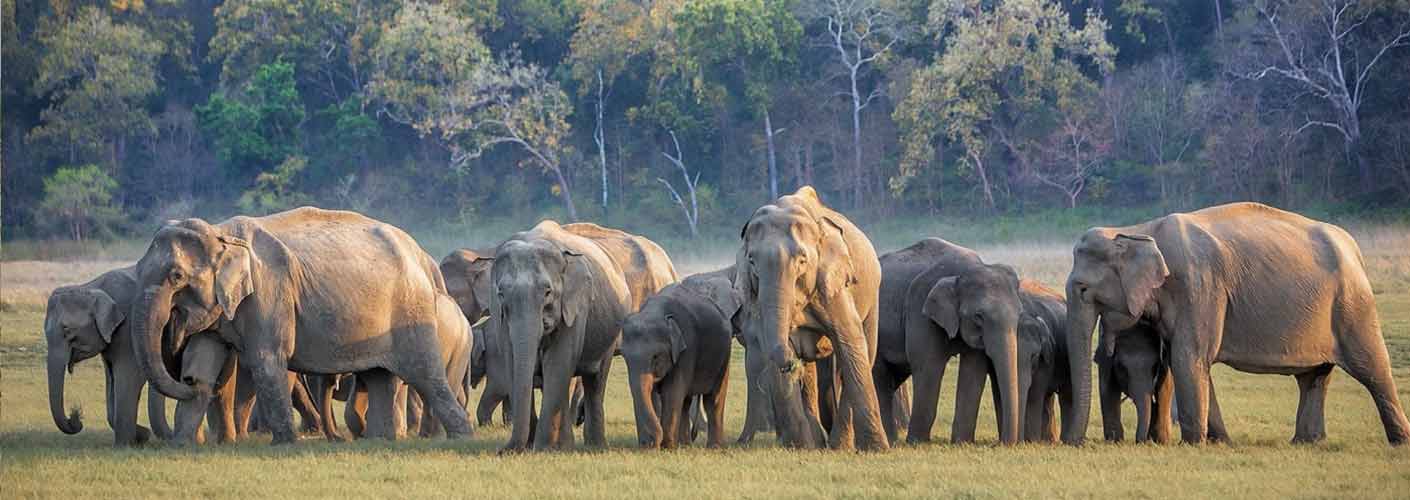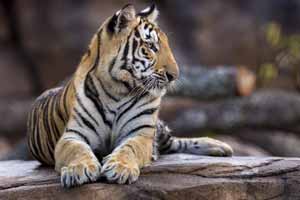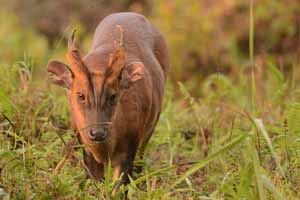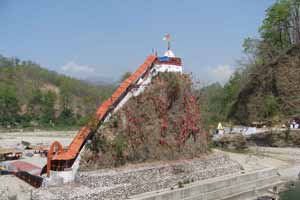
Flora & Fauna
Jim Corbett National Park is famous for natural bounty and wildlife splendour. The Park is spread over more than 520 sq. km. The diverse offering of floral count of Corbett Park is astonishing. There are about 110 types of trees, 51 types of shrubs, 27 types of climbers and 33 types of bamboo and grass are found. The most visible trees seen in Corbett are Sal Shorea Robusta, which is found over 75% of the main area.
Flora
The Jim Corbett National Park is blessed with the natural bounty in the form of distinct flora which comprises of fresh water flora and alpine flora. The various habitat types of Corbett is occupied by Sal forests, Khair-Sisso forests, Mountains, Chaur, and rivers and streams that owes their distinct assemblage of plants. According to botanical survey of India Corbett has 600 species of plants – trees, shrubs, ferns, grass, climbers, herbs and bamboos. These many distinct varieties of plant kingdom makes the national park sought after wildlife destination for those who wish to relax from hectic schedule of working throughout the year.
Trees
Sal, Khair and Sissoo are the most visible trees found in Corbett. Though, there are several other species that contribute to the sound diversity of Jim Corbett are scattered throughout the park. Chir Pine is the only conifer found in the park. Some part of the Corbett is dominated by Bamboo forests. The main species is Male Bamboo (Dendrocalamus strictus) having clustered stout stems and shining papery stem sheaths. Bamboos follow a peculiar flowering process. All bamboos in a forest flower together at the same time once in several decades. After flowering, fruiting and dispersal of seeds, all individuals die together.
Flowering Trees
Green is the fundamental color of nature and variety of flowering trees in Corbett lend that beautiful color to the forests. The forests of the Corbett is dominated by numerous flowering plant, some of them can be named as Kachnar (Bauhinia Variegata) with white tom pink flowers, Semal (Bombax ceiba) with giant red blooms, Dhak or popularly called as the flame of the forest with bright and eye pleasing orange flowers, Madaar or Indian Coral (Erythrinia indica) with red flowers and Amaltas (Cassia fistula) with bright yellow chandelier like blooms.
Shrubs
Floor of the Corbett forest is also dominated by the several species of Ber (Zizyphus) found in open areas and is boon for many birds and animals providing food and habitat to them. Maror Phali (Helicteres isora) is an easily noticeable shrub. If you look at the fruits of this amazing shrub, they are in the form of twisted spiraling pods. Jhau is different kind of shrubs found along the Ramganga basin on sandy or rocky soil.
Bamboo
It is quite interesting to explore the vegetation type of Corbett National Park. We find some of the Corbett vegetation is covered with bamboo forest. Main species existing is named as Male bamboo having clustered stout stems and shining papery stem sheaths.
Founa
Corbett National Park was the first Tiger Reserve under the project in India. So from that point of view Corbett is one of the oldest as well as the largest national park of India. The park is an ideal home for many majestic animals like the Royal Bengal Tiger, Asiatic Elephant and many other wild animals. Due to healthy population of wild today, Corbett is one of best preserved parks with 164 numbers of tigers and over 600 elephants. As per the recent survey Corbett reveals the highest density of population of tigers in the country at 20/100 square kilometers.
One of the well-known species of animals inhabiting Jim Corbett is the Royal Bengal Tiger. It was in the forests of Jim Corbett that India’s tiger conservation program was initiated on 1st April 1973. There was a time when there were many man-eating tigers which dominated the Terai-Bhabar region. However, with a recent decline in the population of tigers, the attacks on tigers have become quite a rare occurrence. Adult tigers could be seen as solitary wanderers to the tourists, whereas tigresses could be spotted with young cubs.
Mammals
Royal Bengal Tiger, Leopard, Jungle Cat, Asian Elephant, Hog Deer, Spotted Deer, Barking Deer, Chital, Sambar Deer, Wild Boar, Black Faced Monkey, Rheus Monkey, Wild Pig and Jackal etc.
Birds
Peacock, Jungle Foul, White Bush Chat, Oriental Pied, Emerald Dove, Red Wattle Lapwing, the Asian Paradise Flycatcher, Rested Kingfisher, Indian Shirks, Indian Alpine Swift, Woodpecker, laughing Thrush, Vulture, Parakeet, kales Pheasant, Oriole, Common Grey Hornbill, Duck, Stork, Cormorant, Parrot, Indian Roller, Teal, Seagull etc.
The Asian Elephant
The Elephant, largest of the land mammals, has been an integral part of the history, mythology, tradition, culture and religion of India. There are three surviving species of elephants in the world, one in Asia and two in Africa. The Asian elephant (Elephas maximus) is distributed in the Indian subcontinent and Southeast Asia. Unlike the African species, Asian elephants have been domesticated for thousands of years and have been used in medieval warfare, for temples, and as a working animal.
Reptiles
Indian Crocodile, Gharial, king Cobra, Krait Cobra, Russels Viper, Python and Monitor Lizard etc. Far far away, behind the word mountains, far from the countries Vokalia and Consonantia, there live the blind texts.






